2018 MERCEDES-BENZ E-CLASS WAGON charging
[x] Cancel search: chargingPage 4 of 506

Atagl ance .................................................... 6
Cockpit ........................................................... 6
Wa rning and indicator lamps .......................... 8
Overhead control panel ................................ 12
Door control panel and seat adjustment ....... 14
Emergencies and breakdowns ...................... 16
DigitalOperator' sManua l........................ .18
Callin g upthe Digital Operator's Manual ...... 18
General notes............................................. 19
Pr otecting the environment .......................... 19
Mercedes-Benz GenuineParts ....................... 19
Operator's Manual ........................................2 0
Service and vehicle operation ....................... 21
Operating saf ety.......................................... .22
Declaration of conformity for wireless
ve hicle components .....................................2 3
Diagnost ics connection ................................ 24
Qualified specialist workshop ....................... 25
Cor rect use of theve hicle ............................2 5
Problems with your vehicle ........................... 25
Re porting saf etydefects .............................. .25
Limited Warranty .......................................... 26 QR codes
forth ere scue card ....................... 26
Ve hicle data storage .....................................2 6
Copyright .. .................................................... 29
Occupant safety......................................... 31
Re stra int sy stem .......................................... .31
Seat belts ..................................................... 33
Airbags ......................................................... 38
PRE-SAFE
®sy stem ....................................... 45
Children in theve hicle ..................................4 6
Pe ts in theve hicle ........................................5 5
Opening and closing.................................. 56
SmartK ey...................................................... 56
Doors ............................................................ 61
Load compartment ....................................... 64
Ro ller sun blinds .......................................... .70
Side windo ws................................................ 71
Sliding sunroof .............................................. 75
Anti-theft pr otection .................................... .80
Seats and stowing .................................... .82
No tes on the cor rect driver's seat position ... 82 Seats ............................................................ 83
St
eering wheel ............................................. .98
Using the memory function ........................ 100
St ow age areas ............................................ 101
Cup holder .................................................. 115
Ashtr ayand cigar ette lighter ...................... .116
Soc kets ....................................................... 117
Wi reless charging of the mobile phone
and connection with theex terior antenna .. 120
Ins talling/ removing thefloor mats .............1 22
Light and visibility................................... 123
Exterior lighting .......................................... 123
Interior lighting ........................................... 127
Wi ndshield wiper and windshield washer
sy stem ........................................................ 129
Mir rors ........................................................ 132
Operating the sun visors ............................. 135
Infrared reflective windshield ..................... .135
Climate control ........................................ 136
Overview of climate cont rol sy stems ......... .136
Operating the climate control sy stem ......... 137
2
Conte nts
Page 26 of 506
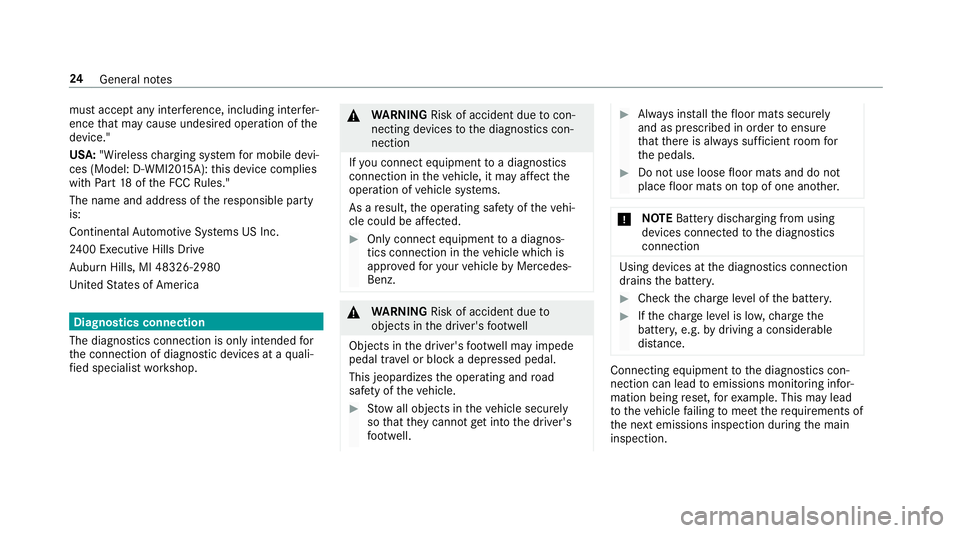
must accept any interfere nce, including inter fer‐
ence that may cause undesired operation of the
device."
USA: "Wireless charging sy stem for mobile devi‐
ces (Model: D-WMI20 15A): this device complies
with Part18 ofthe FCC Rules."
The name and address of there sponsible party
is:
Continental Automotive Sy stems US Inc.
24 00 Executive Hills Drive
Au burn Hills, MI 48326-2980
Uni tedSt ates of America
Diagnostics connection
The diagnostics connection is only in tended for
th e connection of diagnostic devices at a quali‐
fi ed specialist workshop.
&
WARNING Risk of accident due tocon‐
necting devices tothe diagnostics con‐
nection
If yo u connect equipment toa diagnostics
connection in theve hicle, it may af fect the
operation of vehicle sy stems.
As a result, the operating saf etyof theve hi‐
cle could be af fected.
#Only connect equipment toa diagnos‐
tics connection in theve hicle which is
appr ovedfo ryo ur vehicle byMercedes-
Benz.
& WARNING Risk of accident due to
objects in the driver's foot we ll
Objects in the driver's foot we ll may impede
pedal tr avel or block a depressed pedal.
This jeopardizes the operating and road
saf etyof theve hicle.
#Stow all objects in theve hicle securely
so that they cannot getinto the driver's
fo ot we ll.
#Alw ays ins tallth efloor mats securely
and as prescribed in order toensure
th at there is alw ays suf ficient room for
th e pedals.
#Do not use loose floor mats and do not
place floor mats on top of one ano ther.
* NO
TEBattery discharging from using
devices connected tothe diagnostics
connection
Using devices at the diagnostics connection
drains the batter y.
#Checkthech arge leve l of the batter y.
#Ifth ech arge leve l is lo w,charge the
batter y,e.g. bydriving a considerable
dis tance.
Connecting equipment tothe diagnostics con‐
nection can lead toemissions monitoring infor‐
mation being reset, forex ample. This may lead
to theve hicle failing tomeet therequ irements of
th e next emissions inspection during the main
inspection.
24 General no tes
Page 71 of 506

1Sensor detection range
If se veral consecutive kicking mo vements are
not successful, waitte n seconds.
Sy stem limitations
The sy stem may be impaired or may not function
if:
RThe area around the sensor is dirty, e.g. due
to road salt or snow .
RThe kicking movement is made using a pros‐
th etic leg. The
tailgate can open or close unin tentional lyin
th efo llowing situations:
RIf persons' arms or legs mo veinthe sensor
de tection range, e.g. when polishing theve hi‐
cle, sitting on the edge of the cargo compart‐
ment, or picking up objects.
RIf objects are guided behind or placed behind
th eve hicle, e.g. charging cables, tensioning
st ra ps or luggage.
RWhen working on the trailer coupling, trailers
or rear bicycle rack s.
Deactivate KEYLESS-GO (
→page 57) or do not
car rythe SmartK eyabout your person in such
situations.
Limiting the opening angle of the tailgate
Ac tivating the opening angle limiter
Yo u can limit the opening angle of theta ilgate in
th eto p half of its opening range, toappr ox‐
imately 8 in (20 cm) before the end position.
#St op the opening procedure of theta ilgate at
th e desired position.
#Press and hold the closing button in theta il‐
ga te until you hear a short acoustic signal.
The opening angle limiter is activated. The
ta ilgate then stops in thestored position
when opened.
To open theta ilgate full y,pull the handle on the
outside of theta ilgate again af ter it has stopped
automaticall y.
Deactivating th eopening angle limiter
#Press and hold the closing button on theta il‐
ga te unt iltwo short tones sound.
Un locking the tailgate with the mechanical
ke y
#Foldthere ar seat backrest forw ard.
#Re mo vethe combined cargo co ver and net
(→page 108).
Opening and closing 69
Page 122 of 506
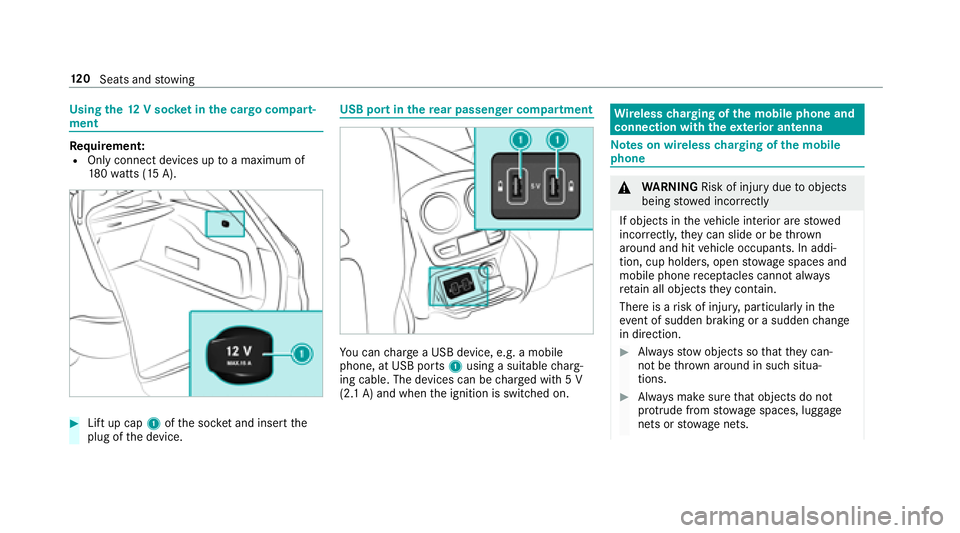
Usingthe12 V sock etinthe cargo compa rt‐
ment
Re quirement:ROnly connect devices up toa maximum of
18 0wa tts (15 A).
#Lift up cap 1ofthe soc ket and insert the
plug of the device.
USB port in there ar passenger co mpartment
You can charge a USB device, e.g. a mobile
phone, at USB ports 1using a suitable charg‐
ing cable. The devices can be charge d with 5 V
(2.1 A) and when the ignition is switched on.
Wire lesscharging of the mobile phone and
connection with theex terior antenna
Note s on wireless charging of the mobile
phone
& WARNING Risk of injury duetoobjects
being stowed inco rrectly
If objects in theve hicle interior are stowed
incor rectly, they can slide or be throw n
around and hit vehicle occupants. In addi‐
tion, cup holders, open stowage spaces and
mobile phone recep tacles cannot al ways
re tain all objects they contain.
There is arisk of injur y,particularly in the
ev ent of sudden braking or a sudden change
in direction.
#Alw aysstow objects so that they can‐
not be throw n around in such situa‐
tions.
#Alw ays make sure that objects do not
pr otru de from stowage spaces, luggage
nets or stowage nets.
120
Seats and stowing
Page 123 of 506
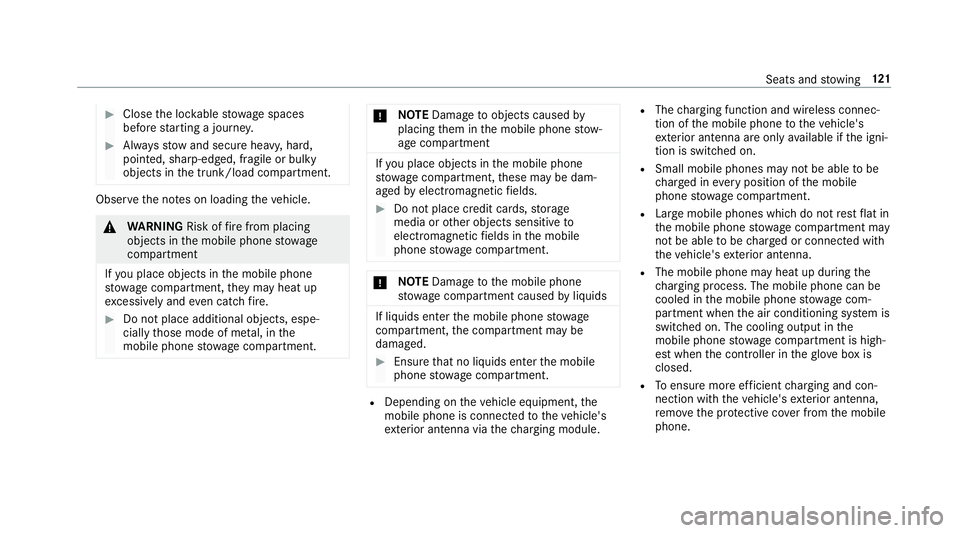
#Closethe loc kable stow age spaces
before starting a journe y.
#Alwaysstow and secure heavy, hard,
pointe d, sharp-edged, fragile or bulky
objects in the trunk/load compartment.
Obser vethe no tes on loading theve hicle.
&
WARNING Risk offire from placing
objects in the mobile phone stowage
compartment
If yo uplac e objects inthe mobile phone
stow age compartment, they may heat up
exc essively and even catch fire .
#Do not place additional objects, espe‐
cially those mode of me tal, in the
mobile phone stowage compartment.
* NO
TEDama getoobjects caused by
placing them in the mobile phone stow‐
age compartment
If yo u place objects in the mobile phone
stow age compartment, these may be dam‐
aged byelectromagnetic fields.
#Do not place credit cards, storage
media or other objects sensitive to
electromagnetic fields in the mobile
phone stowage compartment.
* NO
TEDama getothe mobile phone
stow age compartment caused byliquids
If liquids enter the mobile phone stowage
compartment, the compartment may be
damaged.
#Ensure that no liquids enter the mobile
phone stowage compartment.
RDepending on theve hicle equipment, the
mobile phone is connected totheve hicle's
ex terior antenna via thech arging module.
RThe charging function and wireless connec‐
tion of the mobile phone totheve hicle's
ex terior antenna are only available if the igni‐
tion is switched on.
RSmall mobile phones may not be able tobe
ch arge d in every position of the mobile
phone stowage compartment.
RLargemobile phones which do not rest flat in
th e mobile phone stowage compartment may
not be able tobe charge d or connec ted with
th eve hicle's exterior antenna.
RThe mobile phone may heat up during the
ch arging process. The mobile phone can be
cooled in the mobile phone stowage com‐
partment when the air conditioning sy stem is
switched on. The cooling output in the
mobile phone stowage compartment is high‐
est when the controller in theglov e box is
closed.
RTo ensure more ef ficient charging and con‐
nection with theve hicle's exterior antenna,
re mo vethe pr otective co ver from the mobile
phone.
Seats and stowing 12
1
Page 124 of 506

RWhencharging, the mat should be used if
possible.
Wire lesscharging of the mobile phone
Requ irement:RThe mobile phone must be suitable for wire‐
less charging (Qi-compatible mobile phone).
Yo u can find a li stof Qi-compatible mobile
phones at:
http://www.mercedes-benz.com/connect
#Place the mobile phone as close tothe cen‐
te r of mat 1as possible with the display
fa cing up wards.
When thech arging symbol is shown in the
multimedia sy stem, the mobile phone is
being charge d.
Malfunctions during thech arging process are
shown in the multimedia sy stem displa y.
% Toclean, the mat can be remo ved.
Installing/removing thefloor mats
&
WARNING Risk of accident due to
objects in the driver's foot we ll
Objects in the driver's foot we ll may impede
pedal tr avel or block a depressed pedal.
This jeopardizes the operating and road
saf etyof theve hicle.
#Stow all objects in theve hicle securely
so that they cannot getinto the driver's
fo ot we ll.
#Alw ays ins tallth efloor mats securely
and as prescribed in order toensure
that there is alw ays suf ficient room for
th e pedals.
#Do not use loose floor mats and do not
place floor mats on top of one ano ther.
#To install: pressstuds 1onto holders 2.
#Toremo ve:pull thefloor mat off holders 2.
122
Seats and stowing
Page 125 of 506
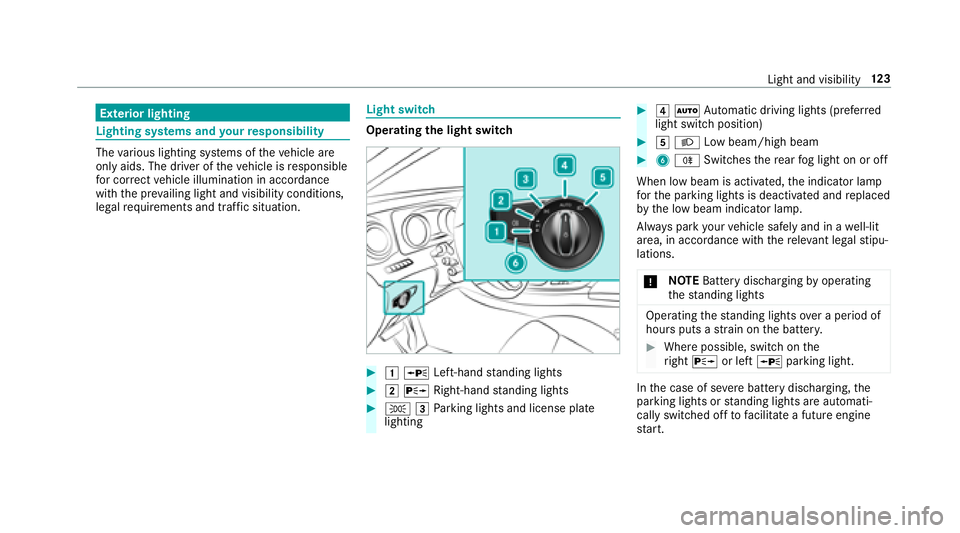
Exterior lighting
Lighting systems and your responsibility
The various lighting sy stems of theve hicle are
only aids. The driver of theve hicle is responsible
fo r cor rect vehicle illumination in accordance
with the pr evailing light and visibility conditions,
legal requirements and traf fic situation.
Light switch
Opera ting the light switch
#1W Left-hand standing lights
#2 X Right-hand standing lights
#T 3Parking lights and license plate
lighting
#4 Ã Automatic driving lights (prefer red
light switch position)
#5 L Low beam/high beam
#6R Switches there ar fog light on or off
When low beam is activated, the indicator lamp
fo rth e parking lights is deactivated and replaced
by the low beam indicator lamp.
Alw ays park your vehicle safely and in a well-lit
area, in accordance with there leva nt le galst ipu‐
lations.
* NO
TEBattery discharging byoperating
th est anding lights
Operating thest anding lights over a period of
hours puts a stra in on the batter y.
#Where possible, switch on the
ri ght X or left Wparking light.
Inthe case of se vere battery discharging, the
parking lights or standing lights are automati‐
cally switch ed offtofacilitate a futu reengine
st art.
Light and visibility 12
3
Page 349 of 506
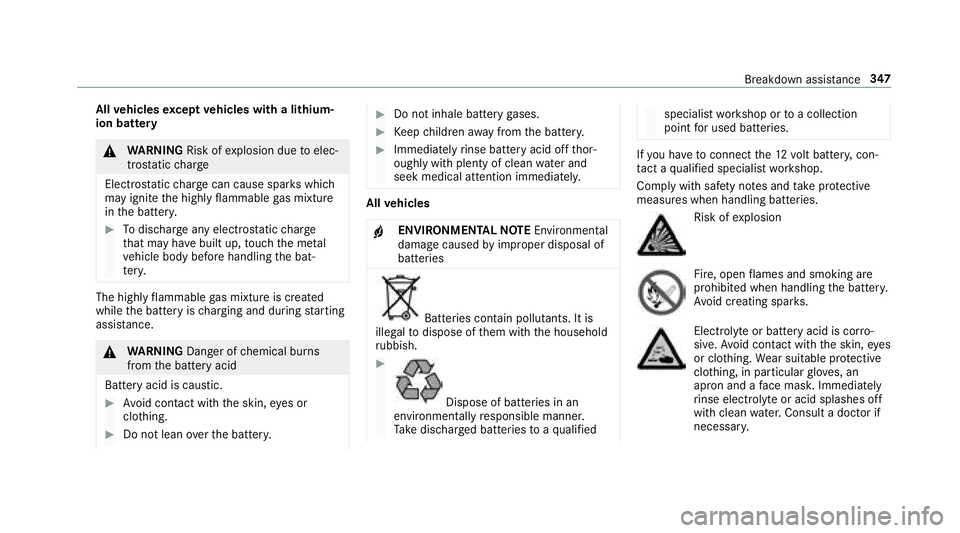
Allvehicles except vehicles with a lithium-
ion battery
& WARNING Risk ofexplosion due toelec‐
tros tatic charge
Electros taticch arge can cause spark s which
may ignite the highly flammable gas mixture
in the batter y.
#Todischar geany electros tatic charge
th at may ha vebuilt up, touch the me tal
ve hicle body before handling the bat‐
te ry.
The highly flammable gas mixture is created
while the battery is charging and during starting
assis tance.
&
WARNING Danger of chemical burns
from the battery acid
Battery acid is caustic.
#Av oid contact with the skin, eyes or
clo thing.
#Do not lean overth e batter y.
#Do not inhale battery gases.
#Ke ep children away from the batter y.
#Immediate lyrinse battery acid off thor‐
oughly with plenty of clean water and
seek medical attention immediately.
All vehicles
+ENVIRONMENTAL NOTEEnvironmental
damage causedbyimproper disposal of
batteries
Bat teries conta in pollutants. It is
illegal todispose of them with the household
ru bbish.
#
Dispose of batteries in an
environmen tally responsible manner.
Ta ke dischar ged batteries toaqu alified
specialist workshop or toa collection
point for used batteries.
If yo u ha vetoconnect the12 volt batter y,con‐
ta ct a qualified specialist workshop.
Comply with saf etyno tes and take protective
measures when handling batteries.
Risk of explosion
Fire, open flames and smoking are
prohibite d when handling the batter y.
Av oid creating spar ks.
Electrolyte or battery acid is cor ro‐
sive. Avoid contact with the skin, eyes
or clo thing. Wear suitable pr otective
clo thing, in particular glove s, an
apron and a face mas k.Immediate ly
ri nse electrolyte or acid splashes off
with clean water.Consult a docto r if
necessar y.
Breakdown assis tance 34
7